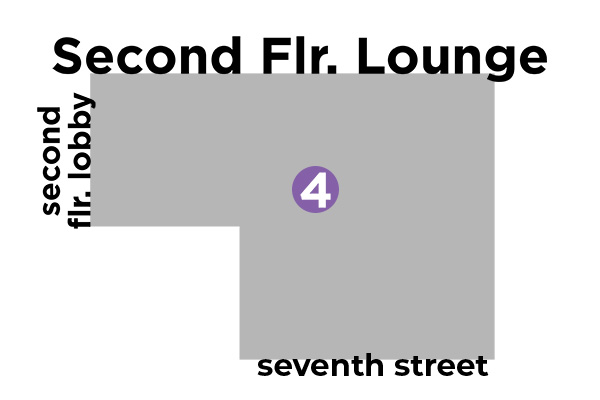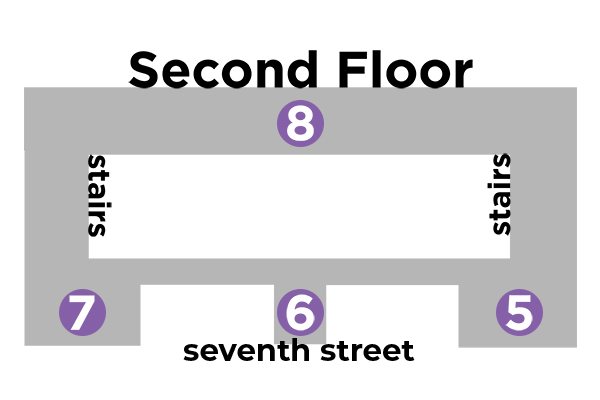Benedum Center Interior Tour

Welcome to the Benedum Center for the Performing Arts! While you’re waiting for the show to begin, explore the theater with this tour and learn more about “Pittsburgh’s Palace of Amusement”. Below are maps of each floor with numbered locations. Each number has a corresponding tour section. As you wander through the Benedum, stop at each numbered location and read the corresponding section




1 — Lower Gallery
Construction and Opening
- Construction of the Benedum began in 1928 in combination with the Clark Building
- The combined cost was $10 million, and the Benedum, or the Stanley at the time, represented $3 million of the cost
- Hoffman-Henon Co. of Philadelphia was the original architectural firm
- Opened on February 27, 1928 billed as “Pittsburgh’s Palace of Amusement”
- Cost of a ticket for opening night was $1.65
2 — Lower Gallery
Historical Restoration
- In 1976 the theater was purchased and remodeled by Cinemette Corp.
- The theater was historically restored to its original condition. Restoration began in June 1985 and finished just before the ribbon was cut on September 25, 1987. As you walk around the theater take notice of the interior to see what the building was like back in 1928.
- This building has been registered with the National Register of Historic Places and is upheld to strict federal rehabilitation standards set by the US Department of the Interior and the Federal Advisory Council on Historic Preservation.
3 — Lower Gallery
Show History
An eclectic variety of celebrities have crossed the Benedum Stage, including:
- Sophie Tucker
- Frank Sinatra
- Ronald Reagan
- Susan Hayward
- Duke Ellington
- Guy Lombardo
- Ozzie Nelson
4 — Second Floor Lounge
Clark Building & Marquee
- In 2017 this wing of the theater was opened, spanning into the original Clark Building. Additional bathrooms were added and have been ranked in the “Seven spots that make Pittsburgh a better place” by the Pittsburgh Post-Gazette.
- Just below these windows sits the Marquee and Theater Signs. There are 3 major signs on the theater which were designed in 1928. Two are restored originals and one is a modification of the original. On the Penn Avenue side of the building, the original sign, fully restored, says “Stanley Photoplays”. In the front of the theater, the sign is outlined with 1,088 chaser lights and old fashioned letter tiles which must be changed by hand by an employee.
5 — Second Floor
Paint
- All of the paint colors on the walls are original.
- During the restoration layers and layers of paint and dirt were carefully sanded away until the original colors were identified and then carefully matched against color charts for the specifications of the new paint.
The Frescoes
- A fresco is a painting done rapidly in watercolor on wet plaster on a wall or ceiling, so that the colors penetrate the plaster and become fixed as it dries. If you look around the lobby you’ll see quite a few.
- All of the paintings in the building are frescoes done on fresh plaster.
- Before the theater restoration the frescoes were crumbling. Pittsburgher Celeste Parrendo, part-time artists and part-time usher at Heinz Hall, restored all of them.
- Celeste had to delicately clean each with cotton swabs and solvents before she could begin painting.
6 — Second Floor
Aluminum Gilt
- The metallic leafing you see all around the theater is aluminum
- To get this affect craftsmen would:
- paint a glue-like substance anywhere they wanted to apply the gilt
- let sit for 2-3 hours
- a sheet of aluminum leaf was then tapped by finger onto the glue
- brushed over with a dry paintbrush
- the foil would then fall away where there had been no adhesive
- If the foil was to have a different tone, tinted shellac would be brushed on
- Fun fact: the sheets of aluminum leaf were so thin that it was hard to hold a piece in your hand without it crumbling
Carpets
- As you walk to the next location notice the carpet. Replicating the carpets was an interesting process. Photos were taken before opening night in 1928, so the original pattern was known. As for the color, a scrap of the original carpet was found in the heating duct and the original colors were identified.
- During the historical restoration it was mandated that the same colors were used.
- 6,500 square yards were woven in England for the entirety of the theater.
7 — Second Floor
Plaster
- Approximately 95% of the interior of the building is plaster
- During the historical restoration, plasterers on scaffolding made latex molds of all the decorative elements and reproduced perfect matches for all of the broken and crumbling segments
- New casts were wired and hand tooled into place
- A 15-man plastering crew worked for almost a year to complete the work
- Each skilled plasterer had one or two apprentices. This way the work on the theater would produce more skilled craftsman
- All of the octagonal coffers in the domed ceiling are plaster, as are the exit signs and the grill work above the boxes inside the theater. Look up when you get to your seats!
Jacquard Fabric
- The side panels of the theater have inserts of jacquard tapestry fabric
- What is jacquard fabric? It is a fabric where the design is incorporated in to the weave instead of being printed or dyed on
- During the restoration there were few fabric houses in the US that still had jacquard looms. Finally a company was found in York, PA. Orinka Mills produced the fabric, but is now no longer in business.
- It took 7 weeks for Orinka Mills to make the 400 yards of fabric that were needed just for the lobbies!
- The fabric is 100% rayon.
8 — Second Floor
Brass Railings
- There are nearly 1,500 feet of brass rail in this building, most of which is original
- When the restoration began, the railings had been removed and dumped in a heap. They were twisted and dented and there was no accurate inventory.
- The architectural firm leading the restoration wanted to use the original brass rails, so they were restored by Francis Nowalk Lighting Co. in Bloomfield.
- They are red brass, which has more copper in it than new brass produced today.
- Of all of the brass fixtures, only the single rail in front of the Director’s Circle is new.
Chandeliers
- There are nearly 100 original chandeliers, torchieres and wall scones in the theater.
- All of the crystal is thought to be Czechoslovakian
- If you look down towards the entrance you will notice 5 chandeliers. One of the chandeliers is not an original due to unrepairable damages. Can you guess which? It’s the center chandelier! You can tell by the orb on the bottom. The middle chandelier’s is slightly different than the rest.
9 — Third Floor
The Structure of the Building
Welcome to the third floor! It’s quite a hike up here, but there are some interesting facts about this area of the theater. Let’s talk about the structure of this building.
- The Stanley Company built this structure and 200 other theaters in a puzzle method.
- First, the land was purchased and the site was prepared.
- Then the brick shell was built
- Next, pre-cut black ironwork was shipped in
- Local ironworkers would then install the ironwork superstructure within the brick shell
- The entire balcony area where you are standing is supported by 1 enormous steel beam, which was brought in pieces and riveted together.
- Finally, plasterers would go to work, hanging the plaster on the ironwork
10 — Auditorium
The Stage
- The Benedum Stage is the 3rd largest stage house in the country.
- It is 28 feet deep and 144 feet wide with 56 ft. by 56 ft. of performance area.
- Dancers from the Pittsburgh Ballet Theatre chose the stage floor after testing 10 different flooring options. The troupe chose a Douglas fir flooring built on a series of neoprene (sponge-rubber) pads.
The Grand Chandelier
- This Chandelier is the signature piece in the theater.
- It weighs 4,700 lbs. and has thousands of crystals
- It is 20’ high and the diameter of the largest layer is about 12’.
- When the Chandelier was first installed it took 8 men, working 16 hour days, one week to assemble the original chandelier
- The Grand Chandelier is lowered once a year to be cleaned by hand.
The Orchestra Pit
- The orchestra pit below is large enough to accommodate 85 musicians.
- It is split into 2 parts with separate elevators.
- Each section can be raised and lowered to stage level to extend the stage, or for more orchestra level seating if need be.
The box seats
- On the sides of the stage you’ll notice box seating. These boxes were never meant for viewing a performance. They are simply decorative. Organ pipes were hidden behind the open grillwork of the boxes when the original organ was in the pit. The $125,000 Wurlitzer organ was destroyed in the St. Patrick’s Day Flood of 1936 and was never replaced.
Seats
- The seats are duplicates of the originals, made a little wider and roomier